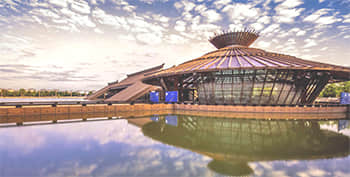Guangfulin Cultural Relics Park

When we refer to the history of Shanghai, we are always reminded that it is a modern metropolis which developed from a small fishing village in the 19th century. Shanghai’s archaeological background is Guangfulin Culture, which reveals stories of immigrants in the early stages of Shanghai and through various social changes.
Guangfulin Cultural Relics have been discovered since 1958, with a series of 4 excavations up to now. It divides the primitive civilization of the New Stone Era into clear types in Taihu Lake.
- Chinese Name: 广富林文化遗址 Guǎng fù lín wén huà yí zhǐ
- Constructed:2014
- Duration: 2-4 hours
- Entrance fee: 40 yuan per person in work time, 50 yuan per person at the weekend
- Opening hours: 09:00-17:00 (after 16:00 not allowed entry )
- Address: Guangfulin Relics Park, Qiubo Road, Fangsong Avenue, Songjiang District, Shanghai
- How to get there: Take No.15, 24, 1801 or 99, and get off at the East China University of Political Science and Law Station. Walk about 200 meters forward to the west.
- Website: http://www.gflpark.com
Attractions of Guangfulin Culture Relics Park
1. Fulin Culture Exhibition Hall
 Fulin Culture Exhibition Hall
Fulin Culture Exhibition Hall (photo from website of Guangfulin Relics Park)
Fulin Culture Exhibition Hall is located in the first roof-shaped building connected to a circular building in the center of the lake, half of which is beneath the water. Entering the exhibition is like a time-travel journey going back to 4,500 years ago. The design of the exhibition divides into the different themes of Guangfulin Archaeological Reminiscence, Shanghai’s Land Development, Ancestors life, the Feature of the City, Booming of the Songjiang County, the rise of Shanghai, and looking into the future, all with an idea of “Time-Travel”.
2. Ancient Pottery Art Museum
The Ancient Pottery Art Museum is located in the underground space of the Fulin Pagoda that connects with the Culture Exhibition Hall. It showcases more than 500 exquisite pieces of pottery, which are provided by the Xiayu Ancient Pottery Museum of Shanghai Association of Collectors. There are masterpieces from different periods, including the primitive era, from the Xia to Zhou Dynasty (about 2224 BCE - 256 BCE), the Spring and Autumn Period (770 BCE - 221 BCE), the Qin and Han Dynasties (206 BCE - 202 BCE), the Wei and Jin Dynasties (220 CE - 420 CE), the Tang (618 - 906 CE) and Song (960 - 1279 CE) Dynasties.
3. Fulin Imprint
 The outlook of the Fulin Imprint
The outlook of the Fulin Imprint
There is a cube-shaped building with stones to the west of the entrance. That is the Fulin Imprint Exhibition Hall. The design of its outlook represents a Chinese seal. This exhibition displays the research of Guangfulin Cultural relics from 1959, documents and materials about events of the archaeological excavation, and the Chronology of the site in the Shanghai Culture Relic Management Committee. The exhibition hall collects food vessel pottery in the center, which is the most typical one in the prehistoric relics of the site. It is said that in folklore the food vessels were used for praying for protection and good luck. When you go up to the observation deck, you can view Fulin Lake and Chen Zilong’s Tomb.
4. Guangfulin Collection Museum
The Guangfulin Collection Museum is an important landmark at the site, which looks like three giant broken pots that are half-buried underground. It exhibits valuable antiques selected from hundreds of thousands remains, some of which are provided by Shanghai Museum.
Drop us a line and we'll connect you with the top China expert in no time!